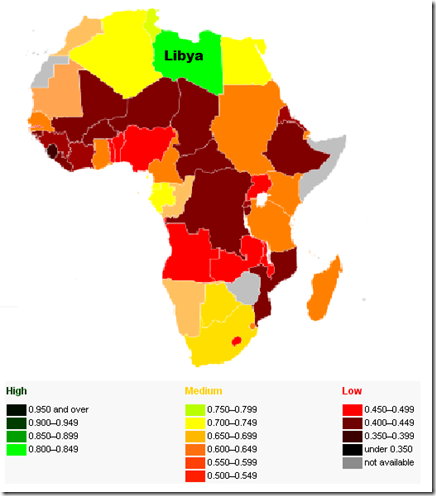Libyan Arab Jamahiriya
Country Profile: Human Development Indicators
Human Development Index
The Human Development Index (HDI) is a composite statistic used to rank countries by level of “human development” and separate “very high human development”, “high human development”, “medium human development”, and “low human development” countries. The Human Development Index (HDI) is a comparative measure of life expectancy, literacy, education and standards of living for countries worldwide. It is a standard means of measuring well-being, especially child welfare. It is used to distinguish whether the country is a developed, a developing or an under-developed country, and also to measure the impact of economic policies on quality of life.
2010 HDI

Human Development Index: Trends 2005 – 2010

Each year since 1990 the Human Development Report has published the Human Development Index (HDI) which was introduced as an alternative to conventional measures of national development, such as level of income and the rate of economic growth. The HDI represents a push for a broader definition of well-being and provides a composite measure of three basic dimensions of human development: health, education and income. Libyan Arab Jamahiriya’s HDI is 0.760, which gives the country a rank of 64 out of 187 countries with comparable data. The HDI of Arab States as a region increased from 0.444 in 1980 to 0.641 today, placing Libyan Arab Jamahiriya above the regional average. Learn more
http://hdr.undp.org/en/
Human Development Index: Health, Education and Income
| Year |
Libyan Arab Jamahiriya |
High human development |
Arab States |
World |
| 2011 |
0.760 |
0.741 |
0.641 |
0.682 |
| 2010 |
0.770 |
0.739 |
0.639 |
0.679 |
| 2009 |
0.763 |
0.734 |
0.634 |
0.676 |
| 2008 |
0.759 |
0.733 |
0.629 |
0.674 |
| 2007 |
0.755 |
0.728 |
0.623 |
0.670 |
| 2006 |
0.748 |
0.721 |
0.617 |
0.664 |
| 2005 |
0.741 |
0.716 |
0.609 |
0.660 |
Human Development Index
Read more about the Human Development Index
Health
| Life expectancy at birth (years) |
74.8 |
Education
| Education index (expected and mean years of schooling) |
0.731 |
Income
| GNI per capita in PPP terms (constant 2005 international $) |
12,637 |
Inequality
| Inequality-adjusted HDI |
n.a. |
Poverty
| Multidimensional Poverty Index (%) |
n.a. |
Gender
| Gender Inequality Index |
0.314 |
Sustainability
| Adjusted net savings (% of GNI) |
n.a. |
Demography
| Population, total both sexes (thousands) |
6,422.8 |
Human Development Index: Trends 2005 – present
The Human Development Index – going beyond income
Each year since 1990 the Human Development Report has published the Human Development Index (HDI) which was introduced as an alternative to conventional measures of national development, such as level of income and the rate of economic growth. The HDI represents a push for a broader definition of well-being and provides a composite measure of three basic dimensions of human development: health, education and income. Libyan Arab Jamahiriya’s HDI is 0.760, which gives the country a rank of 64 out of 187 countries with comparable data. The HDI of Arab States as a region increased from 0.444 in 1980 to 0.641 today, placing Libyan Arab Jamahiriya above the regional average. The HDI trends tell an important story both at the national and regional level and highlight the very large gaps in well-being and life chances that continue to divide our interconnected world. Learn more
To access the Libyan Arab Jamahiriya page of the UNDP Human Development Report click here>>

